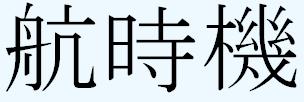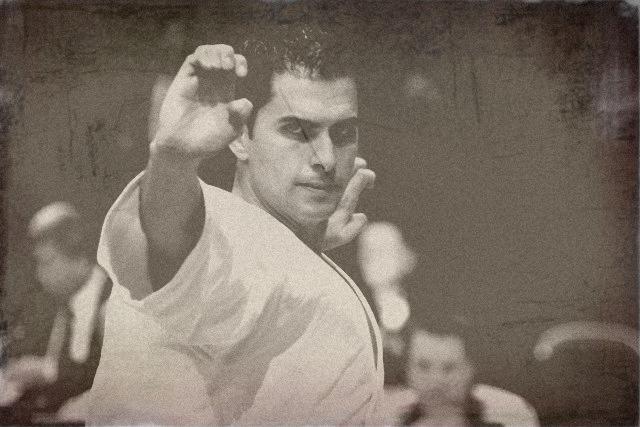To better understand and appreciate the Karate that we’re all practising there are several approaches one may take.
For example, you can train very hard by yourself, and that way try to understand and learn more. Or, you could perhaps teach others and learn more that way. Or why not sit down and philosophize and theorize over certain topics, trying to gain a deeper understanding that way.
We all use different methods depending on our commitment, level and experience, when we want to gain a deeper understanding of something. History tells us that attacking a subject from different angles and viewpoints often proves to be a good way.
good way.
We all know this.
So here’s one for you:
An experiment.
And it’s called “Koujiki”.
First created and done (by me) about one or two years ago, this highly practical and educational (not to mention fun!) Karate experiment, or game, is best suited (and originally created) for the more advanced learner of Karate who wishes to understand kata on a deeper plane.
Yes, kata.
So, I’m telling you right now, if you’re one of those kumite wizards you will probably not have much to gain from this experiment (though it is quite fun to do for everybody).
Okay, so let me explain more about what Koujiki exactly is:
The name is Japanese, and simply means time machine (a rather obscure Japanese term, actually). It’s written like this:
So, as the name implies, this exercise is all about time travel.
Here is how it’s done:
To play Koujiki you only need a couple of things.
- A whiteboard with a matching pen (or just a paper and pen).
- A couple of serious Karate enthusiasts (preferably with an interest in kata).
- Some space for practise (like a dojo).
- A camera or video camera (this one is optional).
And here is what you’re going to do:
Imagine you have stepped into a time machine. You are a couple of hundred years back, and you (along with your training partners) are experienced, old Karate masters (complete with long white beard) about to create your own kata.
Yes, I know it sounds very McDojo-ish, but this is what we’re going to do.
Stay with me.
The purpose of Koujiki is to make its participants understand the process of how, and why, kata were created in the first place. And also, how the development and transmission of kata influenced our modern day situation.
So basically, you’re going to together, systematically, compose a kata.
Let me break it down step by step:
Step #1 – Identifying
The participants start off by together discussing and identifying the most common (physical) acts of violence that we might have the misfortune of encountering in our daily lives.
These attacks are then put together into a list, with the ten most common ones in the top.
When I first did Koujiki, our list looked something like this (here’s where your whiteboard comes in handy).
Try to visualize these attacks in front of you as you read them:
- Double hand push/shove
- Collar grab and swinging punch with the free hand
- Frontal tackle (waist level)
- Bent over neck hold, and face punch with the free hand
- Bear hug (from behind)
- Double collar grab and frontal headbutt
- Etc, etc, etc…
Depending on your local culture (read: neighborhood) these attacks might vary (perhaps even including knives or other weapons).
Now, when these attacks have been identified (with everyone agreeing that these are indeed the most common ones), you are ready for the next step.
Step #2 – Regulating
As you’ve probably figured out, we now need to come up with defensive actions for these attacks.
But the problem we face is: “What constitutes a ‘good’ defense?”
For instance, against the headbutt; Oscar might want to defend himself with a knee to the groin, while Victor likes nothing more than to ‘Mike Tyson’ the ear off of his opponent. So here’s where we need to lay down a set of rules (use that whiteboard again!):
The rules that every defense needs to follow are the following.
Our defense needs to be:
- Easy to remember
- Come spontaneously
- Be practical
So, to take an example:
Defending against a frontal tackle with a mae geri to the jaw bone might be ‘1. Easy to remember’ and ‘2. Come spontaneously‘, but it isn’t ‘3. Practical’ if you’re a girl wearing high heels, if you’re a worker wearing big, heavy boots, or if its winter and you have a lot of ice on the ground (there’s that cultural thing again)!
Every defensive action (what people in the future will refer to as a bunkai) needs to obey these three rules. And when the meaning behind these rules have been understood by every participant, you can erase them and replace them with one rule:
Our defense needs to be:
- Realistic.
And the goal of it all is:
- Control
Control over ourselves, our opponent, and the situation.
Done?
Understood?
Okay, go to step 3.
Step #3 – The ABCD’s
Now that we have established what kind of attacks we’re facing (step #1), and what our defense needs to conform to (step #2), we still have one crucial part left.
“When does the defense end?”
Let’s say I defend against a right hook by jamming it before it hits my head, and then I simply push my opponent away.
Probably not.
My opponent will be even more agressive and most likely attack me again, possibly harder.
So we need to learn the ABCD’s of when a defensive template is ‘good’.
What ends a confrontation?
The ‘bunkai’ needs to attack the following human structures in order to guarantee a stop:
- Air
- Blood
- Consciousness
- Dislocation
A: Air means blocking the air flow of our opponent, constricting it in a realistic (step #2, remember?) way. For example, by choking. A sleeping opponent is a controlled opponent.
B: Blood means constricting the blood flow of our opponent. Blood transports oxygen to our brain, and the result of shutting down the blood flow (perhaps with a strangulation) means we have control. Sleeping opponent is defeated opponent.
C: Consciousness simply refers to knocking our opponent out, making him/her lose consciousness. A solid hook to the chin might do the trick, but so will an elbow smash or a headbutt. Or whatever else you might prefer. Sweet dreams!
D: Dislocation is the only ‘rule’ that doesn’t mean our opponent passes out as a result of our defensive action (though it might happen). However, control can still be achieved by applying an arm bar, breaking a kneecap or simply executing an effective hold in some way. As long as the result is realistic, right? We all know that it takes more than a dislocated finger to stop somebody!
As a bonus, we could add an E to our ABCD, in this case meaning E: Escape. But hey, if we could always escape, what’s the point of practising this stuff to begin with?!
When all of the players/participants of Koujiki have understood that the outcome of every defense must be A, B, C or D, while following the rule of ‘Realistic’ and always having ‘Control’ as the ultimate aim, step # 4 can be undertaken.
Step #4 – Playing
Here, finally, is the physical part of Koujiki.
You look at the list you created in the beginning, and together (everybody should have a partner here) you start coming up with defenses.
Work through your list, from top to bottom, and for every attack together decide which defense to use. Keep it informal, and it will be easier. Allow free thoughts and experiment. After all, this is a game.
With many, many, built in lessons.
Keep an open dialogue. As long as the rules of the game are followed, no technique is superior or inferior.
Just different.
Feel free to use pads, protectors, and your voice. Anything and everything that adds realism.
Discuss, discuss, discuss. And then together decide (vote if you have to) on what defense you will be using for each of the attacks that your list consists of.
Step #5 – The Solo Reenactment
You’re all done?
My guess is… you’ve probably been working at least 5-6 hours now? To play this game properly (which I insist you do) a weekend seminar is really preferred. You will be thinking a lot.
And above all, you will be learning a lot.
Okay, the hardest part is still left:
Doing it all without a partner.
Starting from your first defense, reenact every scenario by yourself. Consider it nothing more than a way of memorizing your various defenses. It’s a tool for remembering. At least for now.
Some techniques will need a defense on both left and right side (collar grab and swinging punch, perhaps) while other techniques only need one defense, since it’s limited to only one side (headbutt for example).
Consider this.
Movements that need to be repeated on both sides should. Even in the solo reenactment.
Remember that the pattern you now perform is the ideal form. Form being pronounced ‘kata’ in Japanese.
In a perfect world, your defense will work perfectly, according to the blueprint, but like Funakoshi Gichin tells us in his 20 Precepts , “Practicing a kata exactly is one thing, engaging in a real fight is another”. That is why practising with a real, live, partner is always preferred over the solo practise, even though people in the ‘future’ will do the exact opposite, for some reason (we’re still in a time machine, you know).
Every participant remembers the solo form?
Every participant knows the meaning behind every movement?
Every participant can apply these movements with a partner who’s excerting “active resistance” (as opposed to “passive resistance”)?
Great.
Now you only have one step left. This one is totally optional.
Step #6 – The Aftermath
Here’s the craziest part. I promise.
Grab your camera, and record the form.
Record both the original defenses along with the solo template. Everything.
Let the participant with the nicest and best looking, proper techniques be the performer, so it’s easy too see for everybody what’s going on. Feel free to speak as you record, explaining every movement.
Now hide the recording! I’m not joking. Put it in a place where nobody will find it, for at least 6 months to a year. Or longer, if you have the patience.
You can now step out of the time machine. Koujiki is over.
At least officially.
Because, when the time is ready, you need to gather everybody again, and compare your kata. Do they look the same? Has there been any changes? Compare with the video. Does everybody remember the purpose of every move? If you put a fancy name on your kata, do everybody still pronounce it the same?
What you find will surprise you.
And teach you.
Game over.






13 Comments